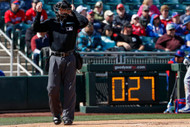It has happened, baseball fans. You’ve probably heard by now that there are new rules for the 2023 season. These changes are in place now and are being implemented in every Spring Training game—and they’ll be in place on Opening Day, which is on March 30th for every MLB team.
This isn’t a test. The “testing” happened in more than 8,000 Minor League games last season, where good results led an MLB committee to vote them in for 2023. MLB players are adjusting right now as they get ready for the season.
The good news is it seems to be working as planned. Games are shorter, with more action. Here’s a recap of the rules that are in place:
- Pitchers on the mound are on the clock between pitches. Infractions cost them a ball. They have only 15 seconds between pitches with no runners on, 15 seconds if there are runners on.
- Batters are on the same clock too. Infractions cause them a strike. The batter must be ready to hit (be “engaged”) with at least eight seconds left on the clock.
- Pitchers and hitters get only two disruptions each per at-bat. The batter can call time just twice. The pitcher can step off the mound or call time just twice.
- The defensive shift is gone. No more stacking the infield or outfield. All four infielders have to stay on the dirt, two on each side of second base, until the pitch is thrown.
- The bases are larger by three inches all around. It’s not only to help first basemen avoid injuries, but to help baserunners.
- Pickoff attempts are limited. The pitcher can throw a maximum of three times, and if he doesn’t succeed on the third attempt, the runner gets to advance a base.
Good for the game. Good for the fans.
During the first week of Spring Training, players had some adjusting to do. There were about two infractions per game, mostly on the pitchers. But if you watched a game in the second week, players seemed to be in the groove. Pitchers had no trouble starting their windups before the pitch count reached zero, and batters seemed to settle in the batter’s box with plenty of time.
In some ways, it was a like a basketball game, where the team with the ball is eager to put it in play. From a fan’s point of view, it was refreshing to see a game played so efficiently.
Players, managers settle in.
In the beginning, some pitchers might have felt rushed. “We felt that the pitchers were rushing, you know, and then they were making pitches at 10 seconds and nine seconds instead of, like, taking your time,” Red Sox manager Alex Cora said. “There’s no rush.”
Indeed, most pitchers seemed to be going into their windups (which stops the clock) with seven seconds still left. As they get more used to the new way, they’ll learn to use more of their time. Cincinnati Reds Manager David Bell had no complaints either. “It was a nice pace,” he said. “It wasn’t rushed, but it kept everything moving.”
A couple of weeks ago, right-hander Glenn Otto started for Texas against Kansas City, giving up two runs on one hit, walking one and striking out five in two innings. He also gave the new pitch timer a positive review. “I liked the pace of play,” admitted Otto. “Change is always going to make some people uncomfortable, but I felt good with it.”
Already, Spring Training games are about half an hour shorter than they were a year ago, running about two-and-a-half hours. Major League games averaged just over three hours last year. More than that, batting averages are up from last year, as are stolen bases, dramatically.
Who made these changes?
The changes were made by an MLB committee that voted on these rules in September of 2022. The committee consisted of four players, one umpire, one person from the Commissioner’s Office and five non-players from different MLB teams. The key rules would be decided by a majority vote. The four players voted against the changes, but the others involved voted for.
According to the MLB Commissioner, surveys of fans revealed they wanted more than they were getting:
- Fans wanted to see more balls in play. The shift turned many would-be hits into outs that wouldn’t have happened 20 years ago.
- Fans didn’t want to have so much dead time in games. The average MLB game was over three hours last year, with pitchers and batters each taking their time to engage.
- Fans wanted more athleticism. Fans wanted to see more extra-base hits and more great defensive plays by infielders playing their positions.
What’s there to complain about?
Year after year, batting averages went down and games got longer, making games less exciting and not as fun to watch. Over the past decade, MLB games and strategy seemed to be dictated more by statisticians than by athleticism and action.
Many fans were tired of the slowed-down, long (perhaps even boring) games that we’ve grown accustomed to over the years. Games were still played on a diamond with nine players per team, but it didn’t look like the game many fans grew up with.
And although these are major rule changes hitting all at once, fans will probably like it more than they think...but only when and if we all get over the notion that “they’re changing our beloved game”…forgetting that sabermetrics had done that already.
Maybe the biggest drawback for fans at the stadiums will be missed innings if the lines are too long at the concession stands!
Resources: mlbplayers.com/player-competition-committee; mlb.com/players-managers-react-new-rules; baseball-almanac.com/hitting.avg; nbcsports.com/mlb-rule-changes-2023; blogs.fangraphs.com/the-2023-rule-changes
